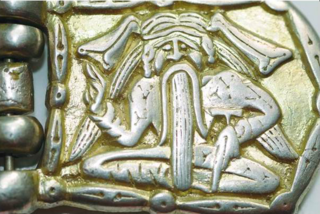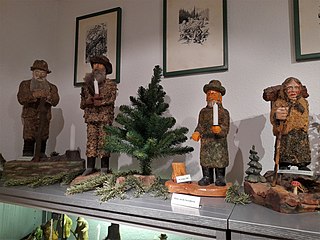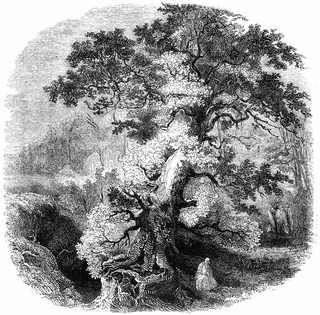
A fairy is a type of mythical being or legendary creature found in the folklore of multiple European cultures, a form of spirit, often described as metaphysical, supernatural, or preternatural.

Lokasenna is one of the poems of the Poetic Edda. The poem presents flyting between the gods and Loki. It is written in the ljóðaháttr metre, typical for wisdom verse. Lokasenna is believed to be a 10th-century poem.
The Askafroa also known as the Danish Askefrue and German Eschenfrau, is a type of legendary creature in Scandinavian and German folklore, similar to the Greek Hamadryads. The Askafroa is the guardian of the ash tree. The Askafroa was thought to be a malicious creature that did much damage, and to appease her, it was necessary to make a sacrifice to her on Ash Wednesday.

English folklore consists of the myths and legends of England, including the English region's mythical creatures, traditional recipes, urban legends, proverbs, superstitions, and folktales. Its cultural history is rooted in Celtic, Christian, Nordic and Germanic folklore.

The Rollright Stones are a complex of three Neolithic and Bronze Age megalithic monuments near the village of Long Compton, on the borders of Oxfordshire and Warwickshire. Constructed from local oolitic limestone, the three monuments, now known as the King's Men and the Whispering Knights in Oxfordshire and the King Stone in Warwickshire, are distinct in their design and purpose. They were built at different periods in late prehistory. During the period when the three monuments were erected, there was a continuous tradition of ritual behaviour on sacred ground, from the 4th to the 2nd millennium BCE.

Grimm's Fairy Tale Classics, also known as Grimm Masterpiece Theater in the original version and The Grimm's Fairy Tales, is a Japanese anime anthology series by Nippon Animation based on the Grimms' Fairy Tales.

The Stone of Jacob appears in the Book of Genesis as the stone used as a pillow by the Israelite patriarch Jacob at the place later called Bet-El. As Jacob had a vision in his sleep, he then consecrated the stone to God. More recently, the stone has been claimed by Scottish folklore and British Israelism.
In Romanian folklore, Muma Pădurii is an ugly and mischievous or mad old woman living in the forest. She is the opposite of fairies such as Zână. She is also the protector of the animals and plants, brewing potions and helping injured animals. She cures the forest if it is dying and she keeps unwanted trespassers away by driving them mad and scaring them.
Estonian mythology is a complex of myths belonging to the Estonian folk heritage and literary mythology. Information about the pre-Christian and medieval Estonian mythology is scattered in historical chronicles, travellers' accounts and in ecclesiastical registers. Systematic recordings of Estonian folklore started in the 19th century. Pre-Christian Estonian deities may have included a god known as Jumal or Taevataat in Estonian, corresponding to Jumala in Finnish, and Jumo in Mari.

A witch ball is a hollow sphere of glass. Historically, witch balls were hung in cottage windows in 17th and 18th century England to ward off evil spirits, witches, evil spells, ill fortune and bad spirits.

Brazilian mythology is the subset of Brazilian folklore with cultural elements of diverse origin found in Brazil, comprising folk tales, traditions, characters and beliefs regarding places, people, and entities. The category was originally restricted to indigenous elements, but has been extended to include:
"The Three Little Birds" is a German fairy tale collected by the Brothers Grimm, tale number 96. The story is originally written in Low German. It is Aarne-Thompson type 707, the dancing water, the singing apple, and the speaking bird. The story resembles Ancilotto, King of Provino, by Giovanni Francesco Straparola, and The Sisters Envious of Their Cadette, the story of the 756th night of the Arabian Nights.

Hungarian mythology includes the myths, legends, folk tales, fairy tales and gods of the Hungarians, also known as the Magyarok.

Folklore of the Low Countries, often just referred to as Dutch folklore, includes the epics, legends, fairy tales and oral traditions of the people of Belgium, Netherlands and Luxembourg. Traditionally this folklore is written or spoken in Dutch or in one of the regional languages of these countries.

White-Bear-King-Valemon is a Norwegian fairy tale. The tale was published as No. 90 in Asbjørnsen and Moe's Norske Folke-Eventyr. Ny Samling (1871). George Webbe Dasent translated it for his Tales from the Fjeld.

The moss people or moss folk, also referred to as the wood people or wood folk or forest folk, are a class of fairy folk, variously compared to dwarfs, elves, or spirits, described in German folklore as having an intimate connection to trees and the forest. In German, the words Schrat and Waldschrat are also used for a moss person. The diminutive Schrätlein also serves as synonym for a nightmare creature.

Many types of trees found in the Celtic nations are considered to be sacred, whether as symbols, or due to medicinal properties, or because they are seen as the abode of particular nature spirits. Historically and in folklore, the respect given to trees varies in different parts of the Celtic world. On the Isle of Man, the phrase 'fairy tree' often refers to the elder tree. The medieval Welsh poem Cad Goddeu is believed to contain Celtic tree lore, possibly relating to the crann ogham, the branch of the ogham alphabet where tree names are used as mnemonic devices.
Giants feature prominently in Welsh folklore and mythology. Among the most notable are Bendigeidfran fab Llyr, a mythological king of Britain during the Second Branch of the Mabinogi, Idris Gawr of Cader Idris, and Ysbaddaden Bencawr, the chief antagonist of the early Arthurian tale How Culhwch won Olwen. Both Arthur and Gwalchmai fab Gwyar feature prominently as giant-slayers in Welsh tradition.
The Story of The Farmer's Three Daughters is an Icelandic fairy tale collected by author Jón Árnason in his 1864 compilation of Icelandic tales and legends. It is related to the theme of the calumniated wife and classified in the Aarne-Thompson-Uther Index as type ATU 707, "The Three Golden Children".












